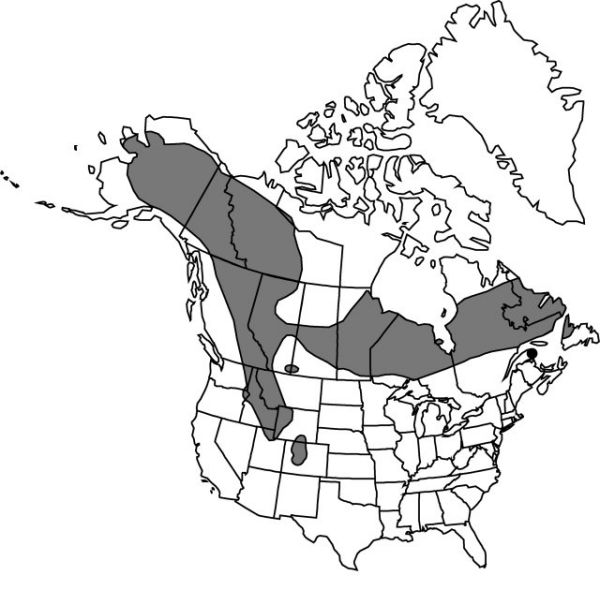Difference between revisions of "Listera borealis"
Bull. Torrey Bot. Club 20: 31. 1893.
FNA>Volume Importer |
imported>Volume Importer |
||
| (6 intermediate revisions by 2 users not shown) | |||
| Line 8: | Line 8: | ||
}} | }} | ||
|common_names=Northern twayblade | |common_names=Northern twayblade | ||
| + | |special_status={{Treatment/ID/Special_status | ||
| + | |code=E | ||
| + | |label=Endemic | ||
| + | }} | ||
|basionyms= | |basionyms= | ||
|synonyms={{Treatment/ID/Synonym | |synonyms={{Treatment/ID/Synonym | ||
|name=Neottia borealis | |name=Neottia borealis | ||
|authority=(Morong) Szlachetko | |authority=(Morong) Szlachetko | ||
| − | }}{{Treatment/ID/Synonym | + | |rank=species |
| + | }} {{Treatment/ID/Synonym | ||
|name=Ophrys borealis | |name=Ophrys borealis | ||
|authority=(Morong) Rydberg | |authority=(Morong) Rydberg | ||
| + | |rank=species | ||
}} | }} | ||
|hierarchy=Orchidaceae;Orchidaceae subfam. Epidendroideae;Orchidaceae tribe Neottieae;Orchidaceae (tribe Neottieae) subtribe Limodorinae;Listera;Listera borealis | |hierarchy=Orchidaceae;Orchidaceae subfam. Epidendroideae;Orchidaceae tribe Neottieae;Orchidaceae (tribe Neottieae) subtribe Limodorinae;Listera;Listera borealis | ||
| Line 30: | Line 36: | ||
|elevation=1500–3000 m | |elevation=1500–3000 m | ||
|distribution=Alta.;B.C.;Man.;Nfld. and Labr.;N.W.T.;Nunavut;Ont.;Que.;Sask.;Yukon;Alaska;Colo.;Idaho;Mont.;Oreg.;Utah;Wash.;Wyo. | |distribution=Alta.;B.C.;Man.;Nfld. and Labr.;N.W.T.;Nunavut;Ont.;Que.;Sask.;Yukon;Alaska;Colo.;Idaho;Mont.;Oreg.;Utah;Wash.;Wyo. | ||
| − | |discussion=<p>In Japan Listera borealis is replaced by L. yatabei Makino, which is nearly identical except for short basal auricles. Listera borealis and L. auriculata are very similar in overall appearance; the ovaries and pedicels in L. borealis are glandular-pubescent, and in L. auriculata they are glabrous.</p><!-- | + | |discussion=<p>In Japan <i>Listera borealis</i> is replaced by L. yatabei Makino, which is nearly identical except for short basal auricles. <i>Listera borealis</i> and <i>L. auriculata</i> are very similar in overall appearance; the ovaries and pedicels in <i>L. borealis</i> are glandular-pubescent, and in <i>L. auriculata</i> they are glabrous.</p><!-- |
| − | --><p>Leaves occur three in a whorl in Listera borealis forma trifolia Lepage.</p> | + | --><p>Leaves occur three in a whorl in <i>Listera borealis</i> forma trifolia Lepage.</p> |
|tables= | |tables= | ||
|references= | |references= | ||
| Line 40: | Line 46: | ||
-->{{#Taxon: | -->{{#Taxon: | ||
name=Listera borealis | name=Listera borealis | ||
| − | |||
|authority=Morong | |authority=Morong | ||
|rank=species | |rank=species | ||
| Line 54: | Line 59: | ||
|publication title=Bull. Torrey Bot. Club | |publication title=Bull. Torrey Bot. Club | ||
|publication year=1893 | |publication year=1893 | ||
| − | |special status= | + | |special status=Endemic |
| − | |source xml=https:// | + | |source xml=https://bitbucket.org/aafc-mbb/fna-data-curation/src/2e0870ddd59836b60bcf96646a41e87ea5a5943a/coarse_grained_fna_xml/V26/V26_1203.xml |
|subfamily=Orchidaceae subfam. Epidendroideae | |subfamily=Orchidaceae subfam. Epidendroideae | ||
|tribe=Orchidaceae tribe Neottieae | |tribe=Orchidaceae tribe Neottieae | ||
Latest revision as of 22:12, 5 November 2020
Plants 4–26 cm. Stems green, slender to stout, slightly 4-angled, succulent, glabrous. Leaves: blade green to dark bluish green, elliptic, ovate-elliptic, or lanceolate, 1.3–6 × 0.7–3 cm, apex obtuse to rounded. Inflorescences 5–20-flowered, lax, 20–90 mm; floral bracts lanceolate, ovate, or oblong, 1–3 × 0.5–1 mm, apex obtuse; peduncle and rachis glandular-pubescent. Flowers pale green, yellowish green, or bluish green with veins darker green; pedicel filiform, 3.5–7 mm, glandular-pubescent; sepals and petals strongly reflexed away from lip and column; dorsal sepal elliptic-lanceolate to linear-elliptic, 4–6 × 1.5–2.2 mm, apex obtuse to rounded; lateral sepals linear-elliptic to oblong-lanceolate, falcate, 4.5–7 × 1.4–2.3 mm, apex obtuse to rounded; petals linear to linear-oblong, falcate, 4.5–5 × 0.7–1.5 mm, apex obtuse; lip oblong, slightly narrowed in center, base with broadly rounded and bluntly angled divergent auricles, apex slightly dilated, cleft into 2 oblong or semiorbiculate lobes, with apicule in sinus; disc 3-veined, lateral veins branched and purplish, base darker green, with ridge in center, thickened along center, 7–12 × 4.2–6.5 mm, margins ciliate; column arcuate, stout, 3–4 × 1 mm. Capsules ellipsoid, 8 × 5 mm. 2n = 56.
Phenology: Flowering Jun–Aug.
Habitat: In moist, rich humus of mossy coniferous or mixed hardwood forests, swamps, often along cold streams fed by melting snow, prefers high acidic soils
Elevation: 1500–3000 m
Distribution

Alta., B.C., Man., Nfld. and Labr., N.W.T., Nunavut, Ont., Que., Sask., Yukon, Alaska, Colo., Idaho, Mont., Oreg., Utah, Wash., Wyo.
Discussion
In Japan Listera borealis is replaced by L. yatabei Makino, which is nearly identical except for short basal auricles. Listera borealis and L. auriculata are very similar in overall appearance; the ovaries and pedicels in L. borealis are glandular-pubescent, and in L. auriculata they are glabrous.
Leaves occur three in a whorl in Listera borealis forma trifolia Lepage.
Selected References
None.